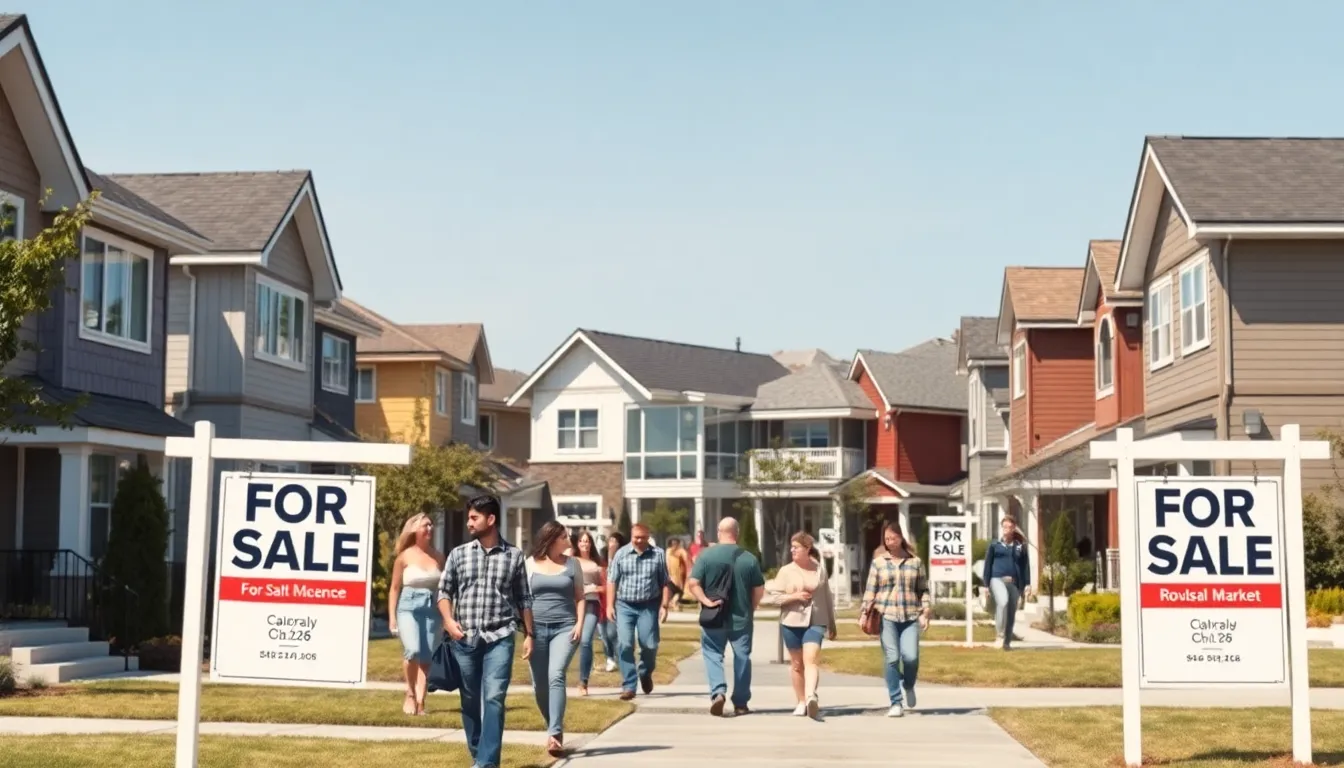The housing bubble phenomenon has captivated economists and homebuyers alike, sparking debates about its causes and consequences. As prices soar and demand outstrips supply, many wonder if the market is on the brink of a major correction. Understanding the intricacies of a housing bubble is crucial for navigating today’s real estate landscape.
Historically, housing bubbles have led to significant economic turmoil, leaving a lasting impact on communities and individuals. With rising interest rates and shifting buyer sentiment, the current market poses both opportunities and risks. This article delves into the warning signs of a housing bubble, its potential implications, and what buyers and investors should consider in these unpredictable times.
Table of Contents
ToggleUnderstanding the Housing Bubble
Housing bubbles reflect periods when home prices surge rapidly, often due to excessive demand or speculation. Understanding their dynamics helps homebuyers and investors navigate market fluctuations effectively.
Definition of a Housing Bubble
A housing bubble occurs when property prices inflate beyond intrinsic values, driven by factors like speculation, low interest rates, and high demand. Typically, an increase in demand outpaces supply, creating unsustainable price growth. When prices outstrip average incomes, it signals a potential correction. Key indicators include rising prices that diverge from historical trends and rapid escalation without corresponding economic improvements.
History of Housing Bubbles
Housing bubbles have historically caused significant economic disruptions. The 2008 financial crisis serves as a notable example, originating from a bubble built on subprime mortgages and excessive lending. Home prices soared from 2000 to 2006, with an average increase of 70% in some markets. The subsequent crash led to millions losing homes and a significant recession. Other examples include the early 1990s and the Dutch housing bubble of the late 1600s, demonstrating the cyclical nature of real estate markets. Each case emphasizes the critical need to monitor housing market conditions for signs of imminent instability.
Causes of Housing Bubbles

Housing bubbles arise from a combination of various economic and psychological factors that distort market dynamics. Understanding these causes helps explain why prices can soar beyond fundamental values.
Economic Factors
Economic factors play a crucial role in the formation of housing bubbles. Low interest rates often encourage borrowing, making mortgages more affordable. This surge in demand leads to increased housing prices, creating an imbalance between supply and demand. Additionally, speculative investment amplifies these dynamics; investors purchase properties expecting future appreciation rather than actual utility. Rapid economic growth can also contribute, as rising incomes enable more people to enter the housing market, further driving demand. Key economic indicators illustrating these factors may include:
| Economic Factor | Description |
|---|---|
| Interest Rates | Low rates facilitate affordable mortgage financing. |
| Employment Rates | Higher employment rates increase buyer confidence. |
| Income Levels | Rising incomes expand the potential buyer pool. |
| Speculative Investment | Increased investment leads to sharp price spikes. |
Psychological Factors
| Psychological Factor | Description |
|---|---|
| Herd Behavior | People tend to follow the crowd, increasing demand. |
| Overconfidence | Buyers may misjudge the sustainability of price growth. |
| Media Influence | Positive coverage can amplify buyer enthusiasm. |
| Fear of Missing Out (FOMO) | Buyers rush to purchase, fearing lost opportunities. |
Impact of Housing Bubbles
Housing bubbles significantly affect both homeowners and the broader economy. The consequences of inflated property values can create long-lasting repercussions for various market participants.
On Homeowners
Homeowners often face immediate and profound impacts during housing bubbles. As prices rise rapidly, homeowners may experience an increase in home equity, leading to greater borrowing against their properties. If prices sustain or increase, this can promote consumer spending. However, once a bubble bursts, homeowners may confront declining property values, resulting in negative equity where the mortgage balance exceeds home worth. This financial strain can lead to increased mortgage defaults and foreclosures, with many homeowners losing their properties and facing long-term credit damage.
Moreover, the psychological impact on homeowners can be substantial. The fear of loss following price corrections can lead to broader market pessimism, affecting their willingness to buy, sell, or invest in real estate moving forward.
On the Economy
Housing bubbles exert considerable pressure on the overall economy. Rapidly rising property values increase construction activity and related jobs in the short term. Economic growth may surge as wealth accumulates among homeowners, fostering consumer discretionary spending. However, once the bubble bursts, the subsequent downturn can trigger a recession, leading to layoffs in construction and related sectors.
In addition, falling home values can lead to decreased consumer confidence, as people perceive their wealth as diminished. This reduction in spending can halt economic growth, creating a ripple effect across various industries. Moreover, the financial sector may experience turmoil as mortgage-backed securities lose value, possibly resulting in financial crises similar to that of 2008. This interconnectedness between housing bubbles and the economy underscores the critical importance of monitoring real estate market dynamics.
Preventing Housing Bubbles
Preventing housing bubbles necessitates proactive strategies from regulators, market participants, and buyers. Implementing effective measures can mitigate risks associated with excessive price inflation and market instability.
Regulatory Measures
Regulatory frameworks play a crucial role in preventing housing bubbles. Implementing stricter lending standards helps discourage excessive credit issuance and minimizes subprime lending risks. Setting guidelines on debt-to-income ratios ensures borrowers maintain manageable debt levels. Additionally, monitoring interest rates is vital; when rates remain low for extended periods, speculative behavior often increases.
Governments can also benefit from enforcing transparency in housing markets. Requiring accurate disclosures and limiting speculative investment stabilizes prices. Various countries have enacted taxes on property speculation and foreign investments to cool overheated markets. Examples, such as New Zealand’s tax measures and Canada’s foreign buyer tax, show how regulatory interventions can successfully moderate demand.
Market Awareness
Market awareness among buyers and investors is essential for bubble prevention. Educating consumers about housing market cycles allows for informed decision-making. Access to comprehensive data regarding average home prices, local market trends, and economic indicators equips individuals to recognize potential bubbles early.
Promoting diversification within investment portfolios helps mitigate risks associated with real estate exposure. Emphasizing the importance of patient investment approaches discourages rash buying decisions based on media hype or short-term trends. Awareness campaigns conducted by real estate associations and financial institutions can further enhance public understanding of housing market dynamics.
Understanding housing bubbles is vital for both homebuyers and investors. As market conditions shift and prices fluctuate, staying informed about the signs and implications of a bubble can help individuals make sound financial decisions. The lessons from past bubbles remind everyone of the potential risks involved in real estate investments.
Proactive measures from regulators and increased market awareness among buyers can play a crucial role in stabilizing the housing market. By recognizing the economic and psychological factors that drive bubbles, stakeholders can better navigate the complexities of real estate. Ultimately, a well-informed approach can mitigate risks and foster a healthier housing market for all.



